Menus
- Sport sofa
- Discovery
- In the saddle
- In the city
- Motorway and expressways
- Departmental
- Part-cycle
- Braking
- Comfort / Duo
- Consumption
- Conclusion
- Accessories
Sport sofa
Unveiled in 2011, the first version of the "Z1000 trail" set new milestones in a segment that was already well represented. The first machine of this type with a four-cylinder, the Versys 1000 skillfully offered a mix of sport and comfort in a much more questionable setting.. Sometimes nicknamed "the fridge", as its massive face lacked elegance, the machine also sported a silencer unworthy of its rank..
The 2015 vintage returns this image to history, its aesthetics now enshrined in a Ninja look, more consistent with the rest of the range, in particular that of the new Z1000SX sport road. After the test of its younger sister, also transfigured, we try the Versys 1000 for a trip on the slopes of Etna, at the snow-capped summit….

Discovery
Goodbye Sadness. The new style of the Versys Kawasaki trails is now more in line with the brand’s standard. The 1000, even more than the 650, is energized, displaying a resolutely sporty mask with tapered double optics. Above, the fork crown is capped with an adjustable bubble, after unlocking two knobs, over 60 mm. Under the lights, a fairing with complex lines flares out in scoops on the sides. These angular front surfaces combine to trap air flows and deflect them. The overall casing, displaying a color distinct from the rest of the machine, is divided by dark elements, "breaking" the volumes and energizing, lightening this new structure..
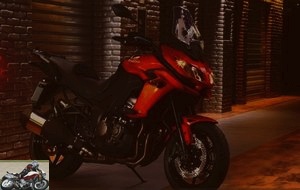
This ends its race around the 21-liter tank. In its extension rests the thick one-piece saddle, surrounded by massive grab handles. Joining in a rack, they also integrate the supports of the suitcases. The rear frame, reinforced and made of partially sheathed steel tubes, is bolted to the main frame. These massive double aluminum side members use the engine as a supporting element to optimize the rigidity of the chassis. Renewed without major change, the four-cylinder benefits from new silent-blocks on its anchor points in order to attenuate its vibrations. The 1,043 cc, double ACT, 15-valve block delivers 118 horsepower at 9,000 rpm and improves torque: 10.2 da.Nm of torque at 7,000 rpm (+0.4 units, 700 rpm higher ). Twin-butterfly injection allows the engine to deliver torque at low and mid-range. The use of these secondary elements controlled by the computer artificially reduces the passage section in order to optimize the filling of the cylinders, whatever the engine speed. New Denso injectors also deliver the mixture more precisely and efficiently to improve efficiency. This set is however controlled by a gas handle devoid of Ride by Wire.

Two engine maps make it possible to refine the accelerations. One gives full mechanical performance, the other reduces its capacity by 75% and modulates the engine response. Another advantage of this electronics, the KTRC anti-skating, can be deactivated and configured on three levels from the console to the left chest of drawers. Mode 1 helps maintain maximum traction in sporty driving, leaving a little more drift to the rear wheel. Mode 2 is more intrusive and Mode 3 activates as soon as a loss of grip is detected. It is dedicated to slippery conditions.
Another valuable piece of equipment is the"Assist & Slipper" clutch uses two types of cams (a lock cam and a slip cam) to compress or separate the pressure plates from the clutch housing. The first relieves the clutch spring, softening the drive. In the event of excessive engine braking (downshifting too fast), the sliding cam then comes into action. It separates the pressure plates from the clutch housing. This relieves the force exerted on the clutch discs, limiting rebound as well as locking the rear wheel. The system also softens the grip of the lever for more comfort.
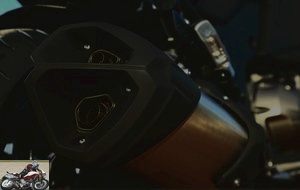
The manifolds now have, on tubes 2 and 3, two new connections optimizing the exhaust flows. The whole is thrown into a more refined silencer, in stainless steel and ends with a massive nozzle with two asymmetrical outputs. Made up of a large aluminum section, the banana-type swing arm collects the energy from the boiler. The welds of its multiple elements are discreet as are the aesthetics of its matte black finish. The Kayaba shock absorber managing its movements is adjustable in compression, by an offset knob and in rebound. Fixed in a horizontal position, this "Back-link" type rear suspension brings the shock absorber closer to the bike’s center of gravity, while helping to centralize the masses. The spring sees its capacity increased, from 10.6 to 10.9 da.Nm. Also reinforced, the Showa 43mm inverted fork features 20mm extended outer tubes for added stiffness and stability. Its optimized mechanism adjusts for preload and relaxation by means of a dedicated wheel on each of the tops of the tubes.
To stop the Versys 1000, four-piston radial-mount Tokico (front) calipers engage two 310mm (+10mm) petal discs and the opposing single-piston Nissin (rear) element grips a 250mm chainring. ABS is still standard, using a smaller Bosch 9.1 MP powerhouse to monitor the wheels. Bridgestone T30 pavement, six-spoke alloy rims.
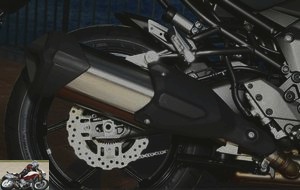
Elegant and racy, the Versys 1000 also takes care of the details. Housings, plates and other metallic elements feature flawless surfaces. Cables and hoses are mostly hidden and two half-shoes protect the lower part of the Japanese block. At the rear, the mudguard goes low to protect the catalyst. Finally, the central stand is standard.
In the saddle
Always so comfortable, the seats are one of the strong points of the maxi trail. The saddle peaks at 840mm (down 5 units), but is wide at the crotch. In addition, the advanced footrests can interfere with the shins when stationary. In the riding position, the available space is important, the flexion of the legs reduced. The passenger enjoys such a pleasant place, placed on a thick cushion. The ergonomics are improved, with a redesigned handlebar and raised by 20 mm by new and solid saddles. We regret that some cables are wrapped in adhesive tape, less present than on the 650, but all the same ….
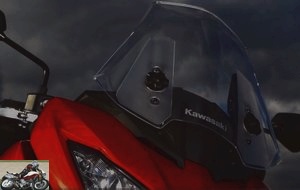
Large, well assembled and finished despite a fork that could still be improved, the cockpit gives a statutory effect. Massive, the instrument cluster takes up the aesthetic codes of adventurers and combines an analog tachometer with a digital window well supplied with information. Tachometer, fuel gauge, engine and ambient temperature. The choice of mapping and traction mode is selected via the sliders on the left stalk. At the top of the screen are successively displayed various information: clock, odometer, two trips, average consumption, instantaneous and remaining autonomy. An "eco" light also appears when driving preserves fuel consumption. KTRC anti-skating and mapping adjust to the left stalk and the levers are adjustable in spacing. Finally, there is a redesigned brake hydraulic jar. A storage compartment integrated into the large fork crown would have been appreciable given the available space..

As on the 650, a new round element appears on the right, offset in the dashboard. It contains, displaying large LEDs, the gear indicator whose integration is questionable, but the display is effective. On the other hand, there is a 12 V socket, unfortunately optional. Our over-equipped testing machines also incorporate hand guards, heated grips adjustable on 6 levels and additional projectors. Suitcases matched to the tones of the machine also flank our frames, as well as a top case.
In the city
Discreet, but deep, the chanting of Akashi’s four-cylinder recalls all the sportiness of the original Z 1000 block. The Versys demonstrates good agility at low speed. Despite a substantial weight, 250 kg in spite of everything, the fairly lively front axle allows the machine to be placed naturally. Immediately noticeable, the damping quality of the suspensions erases the imperfections of urban asphalt. Already fairly contained under braking, the nose landing gear can be further limited by increasing the preload.
Softness of the block and the box complete an appreciable daily pleasure. We will just avoid taking the pretty, but large suitcases in crowded traffic. Particularly flexible, the Kawasaki boiler accepts to evolve on the highest reports in town, without complaining. But as soon as a space becomes free, the ardor of the machine asks only to speak.

Motorway and expressways
In a roaring breath, the Versys 1000 catapults the crew towards the horizon, for a maximum speed of 240 km / h. This is to say that the road on stilts has something to boost travel. However, the top case generates a slight movement of the machine from 150 km / h. At the legal motorway, the engine purrs at 5,000 revolutions per minute on the last gear, always ready to take off on demand.
The protection provided by the windshield and fairings is good, effectively deflecting airflow over almost the entire body. Only the arms remain more exposed. Efficient, the new silent-blocks absorb vibrations and the thick seat could make the boredom of the paid section last more than reason..

Departmental
At a fast pace, the Versys 1000 is efficient and still comfortable. By forcing the rhythm, a slight inertia is felt on the rapid changes of angle. Likewise, the machine requires more engagement when reaching the brakes in bends. Weights and suspensions adjusted for comfort are the cause. A simple adjustment gives more precision to the roadster on stilts. And without reducing comfort. The large lever arm of the handlebars allows entry without forcing the machine, almost with the tips of the gloves. And this especially since the Versys is sensitive to the pressure on the footrests.
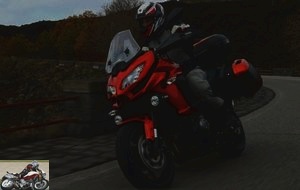
On the corner, the Versys 1000 absorbs compressions without excessive movement. Stable, it relaunches vigorously at the exit of a curve, ready to attack the next, energy that sometimes curbs the anti-skating. Its implementation is gentle and considerate, not causing sudden engine cuts.
In this game, we come to test the limits, very correct, of the ground clearance. Still available, the four-cylinder also likes to go up in towers. On the intermediaries, we benefit from manly times and an excellent extension. From 4,000 revolutions, the Kawa block is furious and flies away after 6,000 rpm. The thrust is ample, sustained and underlined by a metallic rumble in its image.
This dynamic highlights the braking system. Never exceeded, the front calipers deliver strength and progressiveness, but gladly join the services of the rear clamp on the strongest decelerations. The ABS does not intervene inadvertently, regulating only on the most depressed brake sockets.
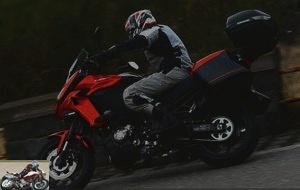
A more calm look, the Versys 1000 emphasizes its ease of handling and its general smoothness. On high-performance road, it allows you to drive far and for a long time, without fatigue.
Part-cycle
Rigid chassis and dynamic front axle combine with adjustable suspensions to ensure good pleasure whatever the riding style. Its relatively large weight benefits from this effective alchemy to be sufficiently forgotten..
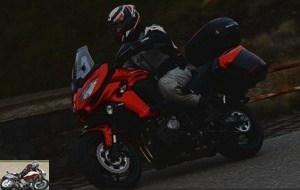
Braking
Particularly dosable, powerful, the front calipers energetically stop the Versys 1000. On the angle, the grip of the levers freezes the direction a little. We will preferably use the rear clamp to seat the road trail on its trajectory. Despite a fairly long stroke, the pedal gives a correct feeling of the retarder.
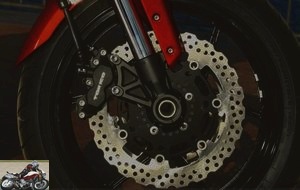
Comfort / Duo
Soft saddles and quality of the suspensions always ensure the Versys 1000 a status of wheelchair "club". Once configured, the fork does not make it play the rocking chairs in fast driving. Pilot and passenger are in the same boat for lounge comfort. The excellent ergonomics of the companion’s handles is also to be noted. Suitcases and top case can accommodate a total of 4 full face helmets. Their simple and efficient operation will optimize trips.
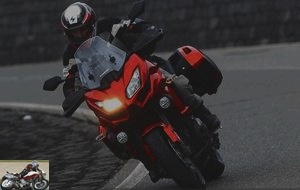
Consumption
Without forcing the pace too much, our machines show 6 to 6.4 liters consumed per 100 km. A correct average for a powerful machine of 250 kg, taking in addition the luggage.
Conclusion
Raised road, the Kawasaki Versys 1000 meets the Akashi brand standards in this segment: efficient, easy and comfortable. Combining strength and softness, the machine seduces both in the long run and in its style. Its new design gives it an aesthetic sportiness, moreover sticking better to its services, which enhances the machine. Plush, its appearance also gives it an elegant statutory presence.
Easy to handle, well equipped, safe and pleasantly finished at all levels, the Versys 1000 is priced at € 12,699. We will oppose him the Triumph 1050 Tiger Sport, proposed at 12,490 €. Its softness at low revs is as attractive as the strength of the relaunches and the availability of its block. However, the ergonomics are a bit dated on board. At Honda, the VFR1200X Crosstourer C-ABS, € 14,099, has the advantage of its powerful V4. Comfort is also not to be outdone on board, but its more typical trail style and its high weight are less flattering. The Italian Multistrada 1200, requiring € 16,690, charges dearly for its fiery character and top-of-the-range equipment.
Particularly well placed in price, the Kawasaki Versys 1000 thus renews, with this opus, with a family resemblance common to the machines of the mark. Now transfigured, the road on heels has better arguments to be the face of your travels.
Strong points
- Engine character and availability
- Agility of the chassis
- Comfort
- Finishes
Weak points
- Lack of electronic assistance
Kawasaki Versys 1000 technical sheet
Accessories
- 2x28L saddlebags: € 475.36
- Saddlebag "one key" lock system: € 42.07
- Saddlebag interiors: € 89.95
- Topcase 47L: € 183.00
- Top case "one key" lock system: € 23.88
- Handguard support: 109.92
- 12V accessory socket: € 94.80
- Additional lights: 389.94
- Crankcase protectors: € 200.10

Related articles
-
Kawasaki Versys 1000 SE motorcycle test
3rd evolution for the shock road trail hybrid 4 cylinders in line, 1,043 cm3, 120 hp and 102 Nm, KECS electronic suspensions, 257 kg, 16,899 euros…
-
2015 vintage The Versys 650, previously based rather in style on the ER6 N roadster, is now forging its own personality with the 2015 vintage. It thus…
-
Kawasaki Versys 1000 motorcycle test
La Z goes green Eternal absent from the Kawasaki range, apart from the unlikely KLV 1000 (Suzuki V-Str m renamed), the maxi-trail model finally appears…
-
Kawasaki Versys 1000 S Grand tourer motorcycle test
Daily test for fifteen days 1,043 cm3, 120 hp at 9,000 rpm, 102 Nm at 7,500 rpm, 257 kg, 15,099 euros (17,099 euros Grand Tourer version) This bike, to…
-
Kawasaki Ninja 1000 SX motorcycle test
Compromise without compromise 4 cylinders of 1,043 cm3, 142 hp and 111 Nm, 235 kg, from 14,349 euros In 2010, Kawasaki presented its first Z1000SX, a…
-
Kawasaki Versys 650 motorcycle test
Twin-cylinder 649 cc, 69 hp, 210 kilos, A2 version, euro5 ready Daily test 2006, the year of the successive revivals of Kawasaki on segments where we…
-
Honda Varadero 1000 XLV motorcycle test
Maxi-Trail with a road vocation The Honda XL 1000 V Varadero, which appeared in 1998, is the heir to the famous Africa Twin … but the manufacturer has…
-
TGV first class Five years ago, Kawasaki presented its first Z1000SX, a road version of its Z 1000 reference roadster. A versatile machine, which has…
-
Authentic avant-garde 4 cylinders of 999 cm3, 152 hp, 106 Nm, 214 kg full made, 19 liter tank 45 years old ! The GSX saga began in 1976 with the GS 750,…
-
Kawasaki VN 1700 Voyager Custom ABS review
Kawa makes the clone …. With her very sleek lowered silhouette and plethora of equipment, this slanted-eyed American is largely inspired by the Harley…
These are the details I would like to know more about. I also read on another site that it was homologated two-seater (which was not the case on the previous one), even if it comes with a single saddle. If they additionally replaced the chambers with tubeless wheels, the price increase becomes more reasonable, compared to what it would have cost to modify the old model. The two-seater homologation was not given, right?
Uh … The Thruxton was already approved for 2 places. The saddle is certainly not super long but it is not a single-seater.
Wouldn’t you confuse it with the Bobber?
Yeah, it’s more like the previous model it was a bit abused. From memory, the two-seater homologation was billed for a few hundred euros (200 or 300 I don’t remember).
If the rims are really tubeless, this new model corrects the rare defects of the previous one. Besides, I’m willing to bet that the switch to the Brembo M50s is there to forget the worries of feeling with the M432s – because as Damien says, they are oversized for this bike..

On the other hand, what tariff inflation…
The Iguana> no, it was originally only homologated as a single-seater. Two-seater homologation was optional .
.
Almost compulsory option, since changing the homologation a posteriori is almost impossible.
These are the details I would like to know more about. I also read on another site that it was homologated two-seater (which was not the case on the previous one), even if it comes with a single saddle. If they additionally replaced the chambers with tubeless wheels, the price increase becomes more reasonable, compared to what it would have cost to modify the old model. The two-seater homologation was not given, right?